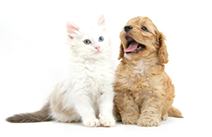How to set up your Bearded Dragon’s home
Heating, feeding and decoration: find out what you need to create the perfect haven for your new Bearded Dragon.
Enclosure
Bearded Dragons must be housed in glass terrariums. Your Bearded Dragon will spend most of its time here, so you want it to be safe and secure. They grow about a centimetre a week, so be prepared to upgrade to a new tank within the first year. The terrarium should have a secure wire mesh lid that provides proper ventilation and allows light through.
Reptile heat lamp
A quality heat lamp is important! Bearded Dragons are ectothermic, meaning they cannot produce their own body heat and must rely on heat sources in their environment.
Thermostat and thermometer
Baby Bearded Dragons like it hot (around 35°C), so that they can digest their food, but you need to offer both a hot and cold zone. Too much heat will cause dehydration and could be fatal. Not enough heat and your Bearded Dragon will have a low immune system and slow metabolism. Getting the temperature right is crucial.
Full spectrum UV light
A good source of UVB light encourages Vitamin D3 to be produced in their skin, which is necessary for your Bearded Dragon to metabolise calcium. Lights should run on timers for about 12 to 14 hours every day. Bearded Dragons need a ‘night’ cycle to sleep. There is no substitute for natural unfiltered sunlight.
Dishes for water and food
Provide clean water in a shallow bowl and change it daily. If there is faecal matter or drowned insects in the water, change it immediately. Avoid using deep bowls, as they are a drowning hazard.
Hideaway
A hiding area or hideaway is a place where your Bearded Dragon can sleep or conceal itself.
Basking rock
A basking rock should be placed in the corner under the heat lamp. The more Bearded Dragons you have, the more basking spots you will need.
Branches
Important for climbing and exercise. Bearded Dragons are climbers and are sure to impress you with their gymnastic manoeuvres.
Quality substrate
This is essentially the ‘base’, like gravel or sand. It should be safe and easy to clean – and preferably something natural.

Diet
Bearded dragons are omnivorous. However, they gradually become more herbivorous as they age. Feed them a variety of insects such as moths, crickets, cockroaches, beetles, spiders and organ meats like chicken heart or liver, many of which can be found at your local Animates store. Insects should be “gut loaded”. They also like a variety of vegetables such as Asian greens, endive, dandelion and squash, just to name a few. Fruit can be fed as treats.
Different dragons like different foods and their preferences will change with age, so don’t hesitate to mix up their diet to provide them with a broad range of vitamins and nutrients.
Calcium supplement
Sprinkle calcium powder on the food to ensure the bearded dragon is getting all the nutrients they require.
Natural sunlight
The most important thing when setting up your bearded dragon’s enclosure is that they have an incandescent UV light that provides UVB light, though remember that there is no substitute for natural unfiltered sunlight. Therefore, it’s important to take your bearded dragon into the sunlight for 20–30 minutes at least 2–3 times per week.
Safe enclosure
Make sure their enclosure is escape and predator proof, with access to shade to prevent overheating.
Appropriate substrate
With the substrate you choose, if your bearded dragon is very young they may ingest some of the sand, so talk to the breeder about what the bearded dragon is used to as it may be better to start with a carpet or newspaper.
Tank Temperature
Make sure that the temperature of their enclosure is a thermo-regulated gradient. This means they have a ‘hot end’ (35-40°C) and a ‘cool end’ (25-28°C). A good thermometer is important to measure the temp in both parts of the enclosure, this needs to be monitored on a daily basis to make sure the temperatures aren't too hot or too cold.
If you have any questions about welcoming your bearded dragon into your home, pop into your local Animates store and ask our friendly store staff for pet care advice and tips.
























